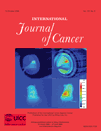Reduced incidence of cervical cancer in mothers of sons with allergic rhinoconjunctivitis, asthma or eczema
Abstract
Because infection with human papillomavirus is a necessary cause of cervical cancer, it is likely that host immunological factors involved in defense against such infections are important for susceptibility to this cancer. By examining associations between allergy in sons and cervical cancer in their mothers, we aimed to test for genetic components involved in both allergy and cervical cancer development. Women born in Sweden between 1932 and 1960 with at least 1 son with medical records from military conscription examination were included in the study (N = 717,963). Among these women there were 41,910 in situ and 3,618 invasive cases of cervical cancer. Hazard ratios of in situ and invasive cervical cancer were estimated as functions of allergic rhinoconjunctivitis, asthma and eczema diagnoses in sons. Adjustment was made for the possible confounders: age, year of birth, education, socio-economic index, geography, number of conscripted sons and total number of offspring. The risk of in situ and invasive cervical cancer was lower for women having sons diagnosed with hypersensitivity (allergic rhinoconjunctivitis, asthma or eczema). Fully adjusted hazard ratios for women with 1 hypersensitive son were for in situ 0.86 (95% CI 0.84–0.88) and for invasive cervical cancer 0.82 (95% CI 0.74–0.91). The protective effects were similar between the 3 allergic diagnoses and increased with number of sons with a diagnosis. There was no significant association between non-cervical cancer in mothers and allergy in sons. These results strengthen the hypothesis that inherited immunological factors are important in determining risk of cervical cancer, probably by affecting mechanisms for viral persistence. © 2006 Wiley-Liss, Inc.




